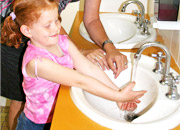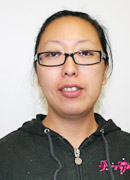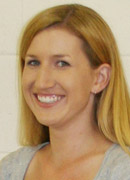Hygiene and safety
Did you know?
If you encourage children to approach all situations creatively, this can help them deal more effectively with events in later life.
Being able to meet your own hygiene needs is an important social skill. When children learn to care for themselves, they feel independent and competent - they feel good about themselves.

Hand washing can be the most pleasant self-help skill to learn if there are low sinks and easy taps to turn on. Washing hands can become a major activity because children enjoy the sensory properties of soap and water.
Introducing hygiene to children of different ages
Each of the staff members below works with a different age group, so they have different ways of introducing hygiene practices and safety issues to the children. Click on each age group to find out more.
0 – 2 years

Patricia works with the 0 -2 years age group. For babies and infants, their health and safety depends on the hygiene practices surrounding them.
You can start to promote autonomy in young children's self help skills by talking to them about what you are doing before, during and after you do it. Have a look at the scenario below as an example of promoting autonomy.
It's time to change Daisy's nappy. Susan, the caregiver in the 0 - 2 years Room, walks over to Daisy, tells her she is about to pick her up, picks her up and on the way to the change area talks about where they are going and what they will be doing when they get there.
While Susan is changing Daisy's nappy, she explains what she is doing and how.
On the way back to the play area, Susan recaps on what just happened. During the whole process she uses a calm and enthusiastic manner. This is to give Daisy a sense of security but also to give her a positive beginning to personal care routines.
Don't forget that young infants need to have their hands washed before and after feeding and nappy changes. You can do this by using an individual face washer for each child. It is important we remember that even very young children can learn good hygiene habits if they're encouraged from an early age, which puts them in good stead for when they are older and using the bathroom.
2 – 3 years

Sara works with the 2 – 3 year old age group. With this group it is important to remember they have reached a stage where the power of observation and attempting routines on their own is very strong. You will find yourself being constantly watched by this age group, so you'll need to be aware of your own personal hygiene acts.
For example, you need to be consistent in your behaviour. Remember to wash your hands:
- after blowing your nose (or a child's nose)
- before and after meals
- at other times, as required.
With this and higher age groups you should share your knowledge with them - this way you can support and encourage safe practices by the children. You can also plan experiences that promote safety and hygiene awareness.
What do you think of the following example?
Make the experience of hand washing enjoyable for the children by singing a song and using hand washing actions. The children can join in with you. Wouldn't that be more fun than just being told to wash your hands?
3 – 5 years

The older the age group, the more autonomy they will have.
With the children in the 3 - 5 years Room, Nicole finds they enjoy participating with her in tasks. They learn a lot through this by following her lead, and they feel valued through cooperating to achieve a task. Some of the tasks that the children in this age group can help with are:
- helping to make a bed
- setting the table
- serving lunch and drinks.
6 – 12 years

To help the children in the Outside School Hours age group (6 - 12 years) learn about hygiene practices and safety, Pierre likes to chat with them about different topics, or debate issues such as sun care and healthy lifestyles.
These older children also like to cooperate with you to achieve tasks. If you are building something, such as a soap dispenser, let them read the instructions too. Alternatively, invite a child to read the instructions out loud so that you are following his or her directions.
Safety
There are lots of safety issues to consider in a child care facility, from sun care to using equipment appropriately. It's up to us as role models to demonstrate safety procedures and explain any issues to children, appropriate to their stage of development.
For further information on safety you can review the Safety checklist.
Choose one of the age groups (0-2, 2-3, 3-5 or 6-12years).
Think of 5 activities that you could provide to reinforce safety or hygiene with the children. Remember to include role modelling in your activities.
Write your activities in your notebook.




